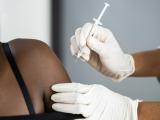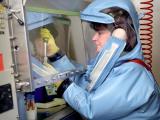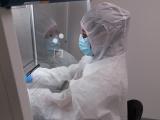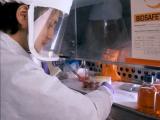The US Centers for Disease Control and Prevention (CDC) said today that it is monitoring and providing antibiotics to about 75 of its Atlanta staff who may have been exposed to live Bacillus anthracis (the bacterium that causes anthrax) after safety protocols weren't followed.
The types of possible exposures point to a low risk of infection, and the investigation so far suggests that other CDC staff, family members, and the public are not at risk for exposure and do not need to take protective actions, the CDC said in a statement.
Early findings suggest that a biosafety level 3 (BSL-3) lab on the agency's Roybal campus was preparing B anthracis samples for lower containment (BSL-2) labs at the same location where research is under way on new methods to detect dangerous pathogens in environmental samples, the CDC said.
The BSL-3 lab's procedure, however, didn't adequately inactivate the samples.
Before the problem was discovered, the potentially infectious samples were moved to three BSL-2 labs that weren't equipped to handle live B anthracis, and workers weren't wearing adequate personal protective gear, according to the CDC.
The CDC said its lab safety investigators found that sometime between Jun 6 and Jun 13, procedures conducted in two of the labs may have aerosolized the B anthracis spores.
The potential unintentional exposure was found on Jun 13 when the original bacteria plates were gathered for disposal and live B anthracis was found growing on them. The CDC said the cultures appeared to be negative for the live bacteria at the time when they were distributed to the lower-containment labs.
Employee health measures
Discovery of the live bacteria immediately triggered an investigation into the health risk, and workers who handled the plates were notified. Environmental sampling was done, and labs and hallways were decontaminated. The CDC said it will reopen the labs when they are safe to operate.
Paul Meechan, PhD, MPH, director of environmental health and safety compliance at the CDC, told Reuters that no employees have shown any symptoms of anthrax illness, which has an incubation period of 5 to 7 days, though some infections have occurred 60 days after exposure.
It's too soon to say if the improper activation of the samples was accidental or intentional, Meechan told Reuters. He added that all employees in the BSL-3 lab that prepared the samples had undergone security clearances as part of the tier one select agent approval process.
He said seven researchers may have had direct contact with live samples, but the CDC is ensuring that all employees who may have been in any of the labs at risks are offered treatment, which consists of a 60-day course of the antibiotic ciprofloxacin and anthrax vaccination, according to Reuters.
Next steps
The agency said an internal investigation continues to find why the BSL-3 lab didn't use validated procedures, and, because its expert protocols weren't followed, disciplinary action will be taken as needed. The CDC also said it would provide refresher training on the safety protocols to all employees who work in the area.
The incident has been reported to the Federal Select Agent Program, the agency said. "It is CDC's obligation to ensure that people feel safe and are safe in the workplace and the community as we conduct our life-saving laboratory work," the CDC said in its statement.
"We will report findings of this investigation and all steps we take to improve lab-safety processes as a result of this incident."
Questions about sample types, deactivation methods
Joseph Kanabrocki, PhD, associate vice-president for research safety and associate professor of microbiology at the University of Chicago, told CIDRAP News that the initial details about the event raise more questions than answers.
He said the level of risk would depend on whether the breakdown in decontamination at the BSL-3 lab involved vegetative bacteria, which pose a lower risk and are easy to kill, or spores, which are difficult to kill, although the infectious dose for anthrax spores is relatively quite high.
Though it's not yet clear, the lower-containment lab may have been working with a spore preparation—not vegetative cells—if they were studying environmental detection, Kanabrocki said.
The handoff of inactivated pathogens from BSL-3 labs to BSL-2 labs is commonly done at many infectious disease centers, because it makes researchers' work much easier and is safer, provided the samples are appropriately decontaminated, he said.
A main question is what decontamination procedures the BSL-3 lab used and at what point the procedure went wrong. Labs routinely use autoclaves to inactivate microbes, including samples of anthrax spores, but equipment failures can occur.
Decontamination processes need to be monitored routinely, with lab workers ensuring that the autoclave cycle achieved the right temperature, pressure, and duration of treatment. The best method to ensure this was done properly involves the use of biological indicators, Kanabrocki said.
He added that some facilities also use chemical decontamination, which would likely be bleach for anthrax. However, contact time with the chemical disinfectant is important, and the process is somewhat more difficult to verify.
Labs run tests to confirm that the pathogens are killed before they are removed from higher containment, and the fact that CDC lab workers found live bacteria growing on plates suggests that the samples were being monitored, Kanabrocki said.
"It is good practice to sample the 'decontaminated' prep and to plate an aliquot to see if anything grows. Growth would indicate that some viable spores were present in the prep," he said.
Kanabrocki said that although the event is alarming, the chances of illnesses resulting from this incident are likely very low.
Margin-of-error concerns
Michael T. Osterholm, PhD, MPH, said the incident at the lab fuels the controversy about gain-of-function work with pathogens such as H5N1 avian influenza. "If this type of problem can happen at a CDC lab, it points out the issues regarding gain-of-function lab accidents." (See today's gain-of-function commentary.)
Osterholm is director of the University of Minnesota's Center for Infectious Disease Research and Policy, which publishes CIDRAP News.
In response to the CDC's announcement today, a US House of Representatives committee that investigated reported lapses in CDC labs in 2012 issued a statement today raising concerns about the event.
A statement from committee chair Fred Upton (R-Mich) and Tim Murphy (R-Penn.), oversight and investigations subcommittee chair, said, "There is no room for error or negligence when it comes to bioterror research and every precaution must be taken to ensure the safety of our scientists.
"The committee has been in contact with the CDC and will continue closely monitoring the situation."
See also:
Jun 19 CDC statement
Jun 19 Reuters story
Jun 19 House Energy and Commerce Committee statement
Sep 28, 2011 CIDRAP News story, "Report: 395 mishaps at US labs risked releasing select agents"


















